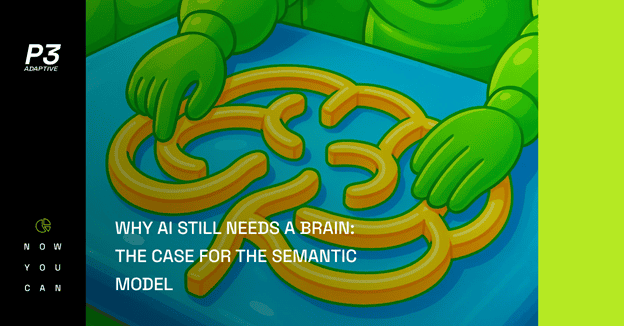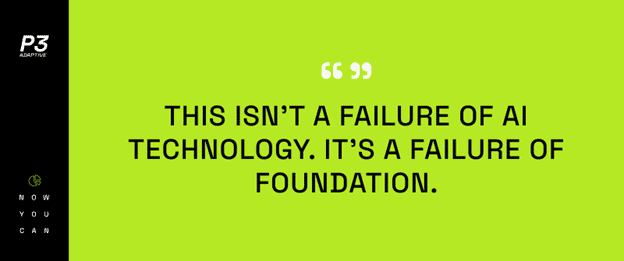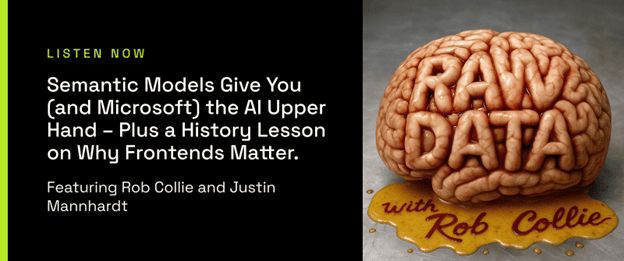
It’s not magic. It’s mechanics.
Everyone wants conversational AI. Nobody asks if it actually understands. Ask for sales by region without a Power BI semantic model and AI ends up drawing from scattered systems, each with its own definition of ‘sales.’ Ask for margin, and your CFO’s eye starts twitching.
That’s not intelligence. That’s guessing at scale.
Microsoft’s latest Power BI move cuts through the noise. Strip away the enterprise speak and Gartner accolades, and here’s what matters: semantic models are the brain that makes AI actually useful.
That idea isn’t new but it just got a major spotlight. Christian Wade over at Microsoft dropped a great post called Power BI Semantic Models as Accelerators for AI-Enabled Consumption, laying out how Fabric’s semantic models are becoming the real engine behind AI. It reminded me of this Raw Data with Rob Collie episode from July, where Rob unpacked how front-ends without semantic layers always look good… and always fail. Microsoft just made that official.
The Problem Nobody Talks About
Most companies have been sold a vision of AI that sounds incredible: just ask your data anything in plain English, get instant answers, make better decisions faster.
Reality? Most AI doesn’t know what you’re talking about.
It’ll check sales data from your CRM, revenue figures from your ERP, and order information from your e-commerce platform yet somehow all three systems will give you different numbers for the same metric. Your AI confidently presents the results, and you’re left wondering which one to trust.
Or worse: it gives you an answer that’s technically correct but completely useless because it doesn’t understand the nuance of how your business defines “active customer” or “completed transaction.” Just like how Tableau won on demo, not depth, back in 2010 — it looked brilliant until you asked it something it didn’t expect.
This isn’t a failure of AI technology. It’s a failure of foundation.
What’s a Semantic Model, Really?
Think of your semantic model as your company’s translator, the connective tissue between messy data reality and actual business understanding.
It’s the layer that defines what “profit” means (is it gross margin? net profit? EBITDA?), how tables connect to each other (customers to orders to products), what calculations should always be applied (discounts, returns, seasonality adjustments), and which business rules govern your data (fiscal year definitions, regional hierarchies, product categories).
Without it, AI is just overconfident intern delivering wrong answers at impressive speed. It might tell you sales are up 20% without mentioning that half your customers haven’t been properly classified, or that the data includes test transactions, or that currency conversions are handled inconsistently.
With a proper semantic model, AI finally understands what your business actually means by “pipeline,” “churn,” or “on-time delivery.” It knows the relationships, the rules, the context that turns raw data into business intelligence.
Microsoft calls Power BI semantic models “accelerators for AI-enabled consumption.” Translation: when AI already knows how your business works, it stops guessing and starts delivering.
Why Most Companies Aren’t Ready
Here’s the uncomfortable truth: some organizations have spent years building dashboards and reports without building solid Power BI semantic layers underneath them.
They’ve got reports pulling from direct database connections. They’ve got Excel spreadsheets with embedded logic that only two people understand. They’ve got Tableau dashboards that work beautifully until someone asks a question they weren’t designed to answer.
These work fine for static reporting. You built it to answer specific questions, and it answers those questions reliably.
But AI doesn’t work that way. AI asks unexpected questions. It combines data in ways you didn’t anticipate. It needs to understand context, relationships, and business rules that are currently locked inside report definitions or, worse, inside people’s heads.
Without a semantic model, your AI is building on quicksand. It might give you an answer, but you won’t know if you can trust it.

Why Microsoft Fabric Changes the Game
This is where Fabric actually earns its hype.
Fabric positions Power BI semantic models at the center, not as a reporting layer tacked on at the end, but as the logic layer that connects data, AI, and people.
The same definitions feeding your dashboards can also power Copilot and, soon, other AI agents. They feed whatever AI tool Microsoft ships next year. One source of truth. No duplicate logic. No “wait, which version of revenue are we using?” debates.
Your AI stops improvising and starts reasoning. Because it finally has a structured, governed foundation that understands your business.
This is fundamentally different from the traditional approach where every tool builds its own understanding of your data. Power BI has one set of definitions, your AI chatbot has another, your automation tool has a third. They all give slightly different answers, and nobody knows which one is right.
Fabric’s direction is clear: build the semantic layer once, use it everywhere—from dashboards to AI tools that understand the same logic.
The Semantic Model as Data Brain
Microsoft’s position makes sense when you think about how AI actually works.
Generative AI excels at language understanding and generation. It’s incredible at translating natural language into queries, summarizing information, and presenting results in readable formats.
But it’s terrible at inventing business logic on the fly. It doesn’t inherently know that your company counts customers differently in Q1 versus Q2, or that certain product categories should never be compared directly, or that “available inventory” needs to account for safety stock levels.
That knowledge has to live somewhere persistent, governed, and accessible. That’s your Power BI semantic model.
Think of it as the difference between asking a smart person who doesn’t know your business versus asking a smart person who’s worked with you for years. Same intelligence, wildly different results.
Mid-Market Teams Win First
Here’s the twist that should make you grin: Big enterprises spent millions building sprawling data foundations over the past decade. They’ve got data warehouses, data lakes, data meshes, and every other buzzword architecture you can imagine.
And they’re still wrestling those monsters into something AI can actually use. Because they built for reporting, not for reasoning. They optimized for answering known questions, not for handling unknown ones.
Mid-market teams can start cleaner—fewer legacy systems, fewer committees.
Build around Power BI semantic models and Fabric’s open architecture, and you can:
Define things once, use everywhere. That “revenue” calculation you built for your dashboard? It automatically powers your AI queries and analytics models—and can feed predictive tools when integrated. No copy-paste logic. No version drift.
Move at startup speed with enterprise clarity. You don’t need six-month projects to “align on data strategy.” Build on to Power BI semantic models iteratively as you need them, starting with the most critical business metrics.
Scale AI that actually understands your business from day one. When Copilot launches a new feature, you don’t scramble to adapt. Your semantic model already speaks your business language.
This isn’t about adding more AI features. It’s about giving the AI you have a brain that speaks your language.
What This Actually Looks Like
Without a semantic model, here’s what happens when you ask AI about sales performance:
“Show me regional sales for Q3.”
AI pings your systems, finds “sales” in three places with slightly different numbers, picks one without telling you why, ignores the fact that two regions report on different fiscal calendars, and gives you a confident answer that’s subtly wrong in ways you won’t discover until the monthly review meeting.
With a properly built semantic model:
“Show me regional sales for Q3.”
AI knows exactly where to look because your Power BI semantic model defines the single source of truth for “sales.” It knows how to handle the fiscal calendar differences because that logic lives in the model. It applies the correct regional hierarchy because you defined it once, correctly. It excludes test data, applies the right currency conversions, and factors in your return policy—all automatically, because that knowledge is baked into the foundation.
The question looks the same. The AI sounds equally confident. The difference is whether you can actually trust the answer. As Rob says, whatever AI you choose, it still needs the engine that speaks your business language.

Where We Come In
Microsoft builds the platform. P3 makes it work for your actual business.
We’ve spent years building data brains—ssemantic layers that power today’s BI and set up tomorrow’s Copilot, predictive, and automation capabilities.
Most consulting firms will tell you that you need a nine-month “data transformation initiative” before you can think about AI. They’ll want to rebuild your entire data warehouse, implement formal governance processes, and create a center of excellence.
We start differently. What questions do you need answered? What decisions are you trying to make? What’s the smallest semantic model that delivers real value?
Then we build that—in weeks, not quarters. You get something working fast enough to prove value, comprehensive enough to scale, and structured enough that when Microsoft ships the next AI feature, you’re ready.
If you want your data to explain itself instead of just showing up in charts, it starts with your semantic model. That’s where real AI begins.
If you’re ready to build AI that speaks your business language, let’s talk.
Get in touch with a P3 team member